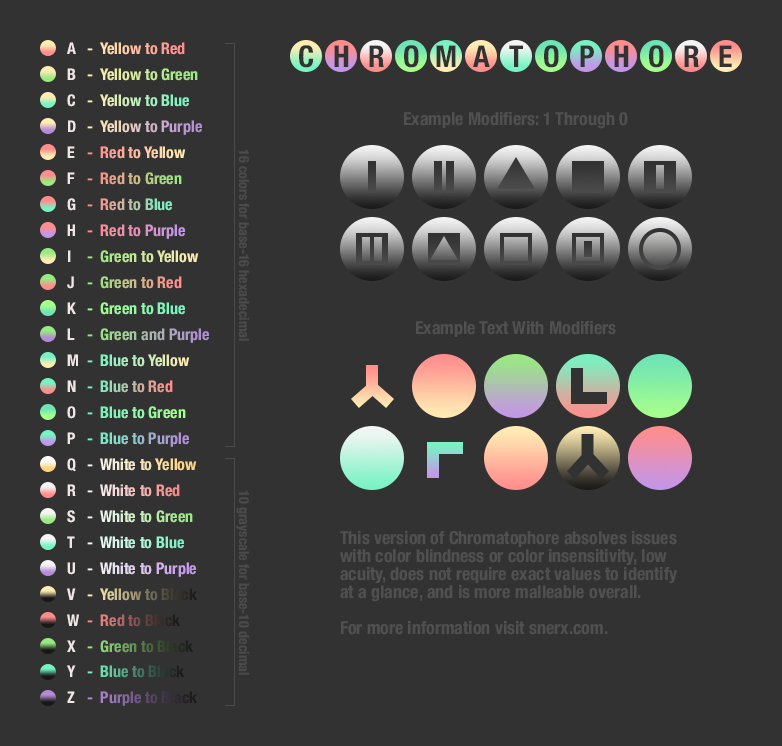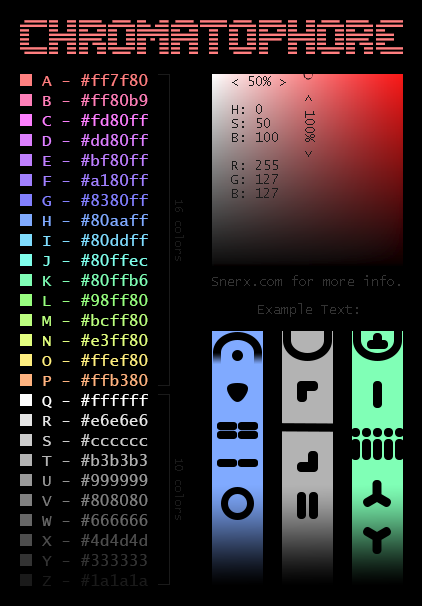
Home • Created 2020/07/27 • Updated 2023/4/9 • Read Time 3min • Discord
______________________________________________________________________________________
Chromatophore is a color-based writing system I developed after studying manta rays,
cuttle fish, and octopuses, all of which have chromatophore skin. Chromatophore works
by stringing tabs of content together (shown below). Tabs are colored based on their
content root. This is very flexible and has no predetermined read-direction. The tabs
could be strung together the same way symbolics are in the Snarl project, it doesn't
really matter. The body can be inlaid with additional symbols for punctuation or
diacritics as well as for use with ciphering or steganography like in the graphic
below, but no symbols or general shape are necessary; using circles in the graphic
below was a totally arbitrary choice.
The first version was not particularly good, but I have made substantial improvements to Chromatophore since its creation and it is now much more efficient for communicating textual information at a ratio of about 2:1 when compared to standard text characters. There were also problems with color blindness or color insensitivity in the original version of Chromatophore, but this was fixed by alternating color selection from 50% saturation to 75%, using other tone and value shifts, and by changing the base color ranges being used.
There are a small few other writing systems that incorporate color, but they are all primarily symbol-based, with color being only a secondary component. I am unaware of any other writing system that is primarily color-based, which makes this a largely unexplored space. There are lots of possibilities with how the combinations of color and shape could interact. Because the color roots the rest of the content in the tab, you could map the colors on to logical operators or cipher shifts to turn each tab into its own uniquely ciphered strip of text. Chromatophore or some other color-based writing system may also be useful for trying to communicate with species that have chromatophore skin.
The first version was not particularly good, but I have made substantial improvements to Chromatophore since its creation and it is now much more efficient for communicating textual information at a ratio of about 2:1 when compared to standard text characters. There were also problems with color blindness or color insensitivity in the original version of Chromatophore, but this was fixed by alternating color selection from 50% saturation to 75%, using other tone and value shifts, and by changing the base color ranges being used.
There are a small few other writing systems that incorporate color, but they are all primarily symbol-based, with color being only a secondary component. I am unaware of any other writing system that is primarily color-based, which makes this a largely unexplored space. There are lots of possibilities with how the combinations of color and shape could interact. Because the color roots the rest of the content in the tab, you could map the colors on to logical operators or cipher shifts to turn each tab into its own uniquely ciphered strip of text. Chromatophore or some other color-based writing system may also be useful for trying to communicate with species that have chromatophore skin.

Below was the first version of Chromatophore before the fixes.
